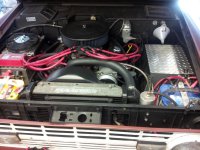All modern cars have a coolant recovery system. You can easly install one or not worry about it. The recovery tank system will keep your raidator full of coolant and the tanks are see through so you can ckeck the coolant level hot or cold.
Definitely a good idea to do this on any Bronco. Real estate is at kind of a premium under our hoods, but you can use anything from a stock replacement from a later model Bronco, or a custom, or even a junkyard swap like a lot of us are doing these days.
Without one, even with a good cap you can eventually puke out most of your coolant, one little bit at a time. Been there many times over the years when I was daily-driving mine.
The changeover was finally mandated due to pollution laws more than anything else I bet. Anti-freeze is a poison and pollutant of the first order. And having it puke out of every water-cooled vehicle on the road was just getting to be too much.
Years ago raidators had tanks built on top of them. When the engine was cold you could remove the cap and look in to see the level of coolant. The coolant was eirther filled to the top and left to seek its own level or after a while you could judge how far down was OK. When cross flow radiators became poplar the radiator had a small tank on the side and filled it was the level of the top the radiator core. To get 100% use it has to be filled to the top. A coolant recovery system was added. When the coolant expands it is pushed into the tank and when it cools it is sucked back keeping the tank full. Your EB has a cross flow radiator and should have a recovery system to work correctly
The cross-flow design is generally considered to be the more efficient one. But packaging and the cost of change must've come into play as well, since there was a long period of time during the general changeover (about 20 years or so?) where manufacturers used both types. Sometimes even in the same body style vehicle with different engines.
Broncos are a perfect example, where the V8's got the cross-flow and the I-6's got the down-flow. Not sure if the 6's shared the surge tank up to '68 too or not.
Full size Ford trucks often stayed with the down-flow up to '79. Came in at least two sizes. My '79 had the small one, but now has the super big downflow, while my '83 came a super wide crossflow.
Both types had no recovery tank in the early years, and both types got the recovery tanks in later years.
Quite a few modern vehicles, due most likely to design constraints under the hood, have the modern version of a surge tank, typically called a "de-gas" tank, where there might not even be a filler neck or cap on the radiator at all. In those cases the separate tank is the high point in the system and ''T's" into the main inlet or outlet lines with larger diameter hoses comparable in size to the main hoses.
A '96 Saturn and a '98 Lincoln Towncar that I'm working on have this type of system. You can't even see the radiator in the Towncar. Just the de-gas bottle and cap.
I have seen pictures of some early Broncos with expansion tanks built into the top radiator hose and it does not have a recovery system.
Correct. Recovery tanks were not in regular use on EB's until '73 or so. The surge-tanks you saw were only on EB's until about '68 or so. One of their primary functions on vehicles back then was to make sure that the cap/tank was the highest point in the cooling system. Maybe the sloping tight fit area at the lead edge of the Bronco hood worried them enough so that they put the cap on a tank farther back where they could get more height? Don't know the original reasoning, but that makes sense.
That sloping hood might have made the designers feel it was needed as the normal location for a cap was a bit borderline in height on an EB.
Not that bad though, as it turns out, as they finally just got rid of the separate tank and went to the more common filler neck on the side tank.
It could have been simply for cost savings too. Not sure.
I'm not aware of any cooling-related trouble specifically caused by this change, but when it comes to refilling after a full drain, it definitely helps to burp the system. I've often had to point the nose of the Bronco uphill to let all the air pockets work their way forward more quickly into the top of the radiator. Not doing so usually resulted in a couple of days worth of driving, filling, driving, filling, etc, until it was topped off.
Maybe some of the cooling problems some EB's have are related to the removal of the surge-tank after all? Maybe the general flow of coolant through the system is just not efficient enough to overcome other modifications and heat adders? That would be an interesting avenue to pursue scientifically.
Anybody want to put their filler cap through the hood? ;D
Paul











